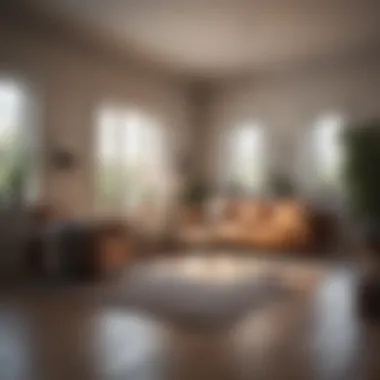Calculating Square Feet of a Room: A Comprehensive Guide


Intro
Calculating the square footage of a room is a fundamental skill for many. Understanding square footage not only aids in layout design but also plays a significant role in real estate transactions. When considering purchasing a home, knowing how to measure spaces accurately can determine if a property meets your needs. This guide aims to provide comprehensive insights into the methods and tools required for calculating square footage.
Square footage is crucial for optimizing space, whether designing a cozy living room or planning a functional kitchen. The process does not just involve simple geometry; it requires a keen eye for detail. This guide will delve into specific measurement techniques, tools that can enhance accuracy, and methods tailored for different room shapes. Following this guide will equip you with the knowledge to tackle common challenges in measurement and ultimately enrich your home design experience.
Foreword to Square Footage
Understanding square footage is crucial for both homeowners and renters alike. This concept serves as a fundamental metric in real estate, interior design, and construction. Knowledge of square footage aids in determining the size of spaces and influences decisions regarding layout, renovation, and purchasing. In this guide, we will explore the methods of calculating square feet, emphasize the importance of precision, and provide insights into common measurement techniques.
Accurate measurements can greatly affect how we perceive space. They can influence not only aesthetic choices but also functional aspects like furniture arrangement and traffic flow. Whether you aim to redesign a room or assess a property for purchase, knowing the square footage can profoundly impact your decisions.
Defining Square Footage
Square footage is a measure of area that defines the total space within a room or building. It is calculated by multiplying the length by the width of a given area, resulting in a measurement expressed in square feet. For instance, if a room measures ten feet in length and twelve feet in width, its square footage would be 120 square feet. This singular metric helps visualize and compare spaces across different properties or settings.
In practice, several factors can influence how square footage is interpreted. For instance, ceilings, structural elements, and built-in features may alter functional use of the measured space. It is necessary to consider not only the numbers but also how the physical dimensions integrate into overall room design.
Importance of Accurate Measurements
Accurate measurements are essential in avoiding costly mistakes. When planning renovations, selecting furniture, or buying a new home, even small inaccuracies can lead to significant issues. Misjudgments in square footage can affect everything from real estate valuations to architectural designs.
"Accurate area measurement ensures not just compliance with regulations but also aligns with individual preferences in design and functionality."
When undertaking any project that involves modification or planning, ensure to use the right tools and techniques for measurements. This foundation establishes a reliable basis for further decision-making about space optimization and functionality. Some common pitfalls include neglecting to measure for obstructions or making estimations rather than precise calculations. Therefore, consider developing a systematic approach to measuring to fortify accuracy in the results.
Tools Required for Measurement
When calculating the square footage of a room, using the right tools ensures accuracy and efficiency. Measurement can initially seem simple, but there are nuances involved that can influence the outcome. With the right equipment, you can eliminate errors and increase the reliability of your results. Selecting proper tools allows for flexible approaches, whether you are working in residential spaces or for more complex projects.
Measuring Tape
A measuring tape is an essential tool for any measurement task. Typically, it is a retractable, flexible ruler that can measure length or distance. Ideal for smaller spaces, a standard measuring tape varies in length, but most commonly, it extends to 25 feet (7.6 meters) or longer. The advantages of using a measuring tape include its portability and ease of use. It is particularly beneficial for measuring dimensions in tight spaces where a laser tool might be impractical.
To get accurate measurements, ensure the tape is straight and aligned with the corners of the walls. Be cautious about recording measurements accurately to avoid compounding mistakes. Regularly check your measuring tape for wear, as inaccuracies can occur from a bent or damaged tape.
Laser Distance Measure
A laser distance measure offers a modern alternative to traditional measuring tools. This device employs laser technology to find distances precisely, often within a few millimeters. It is particularly effective for larger rooms where a measuring tape might be cumbersome. The ease of pushing a button instead of stretching a tape can save time and reduce physical strain.
The laser measure typically allows for additional calculations, such as area and volume, which can be particularly useful for quick assessments. However, it is essential to ensure a clear line of sight when taking measurements. Avoid reflective surfaces that can cause erroneous readings. Practicing with a laser distance measure before beginning major calculations can also help maximize accuracy.
Graph Paper and Pencil
Utilizing graph paper along with a pencil can be a valuable step in the measurement process. Drawing a to-scale representation of the room can facilitate understanding of the space layout. Graph paper provides a structured background, helping maintain proportionate dimensions as you sketch out the room. This method is particularly useful when dealing with rooms that have awkward designs or multiple areas.
By marking the dimensions directly on the graph paper, one can easily visualize the space. It aids in planning furniture arrangements or renovations. It is advisable to keep the pencil sharp for clear markings. Consider using colored pencils to differentiate various features such as doors, windows, and fixtures. This visual aid complements numerical measurements by providing a holistic view of the space.
Basic Measurement Techniques
Understanding basic measurement techniques is essential when calculating the square footage of a room. These methods provide a structured way to obtain accurate dimensions, which are crucial in various applications, such as real estate assessments, home renovations, and interior design projects. By mastering these techniques, one enhances the ability to create precise room layouts and ensure that space is used optimally.
Measuring Rectangular Rooms
To measure a rectangular room, the approach is straightforward. Typically, you begin by identifying the length and the width. It is important to use a reliable measuring tool, such as a measuring tape or laser distance measure. Start at one corner, measure along one wall until you reach the opposite corner, and record that distance. Then, repeat the process for the other two walls. Once both measurements are noted, you multiply the length by the width:
[\textSquare Footage = \textLength \times \textWidth]
For instance, if a room measures 12 feet long and 10 feet wide, simple multiplication provides the area:


[\textSquare Footage = 12 \text ft \times 10 \text ft = 120 \text sq ft]
This method yields clear and concise results, making it a preferred option for many.
Measuring Irregularly Shaped Rooms
Measuring irregularly shaped rooms can pose more of a challenge. However, breaking down the room into recognizable sections simplifies the process. Two effective techniques for this include dividing into rectangles and applying trigonometry.
Dividing into Rectangles
Dividing a room into rectangles allows for easier calculations. This method involves splitting the irregular space into smaller rectangles. Each rectangle can then be measured separately, using the same length and width calculations discussed. The individual square footage of each rectangle is calculated and summed to obtain the total.
This approach is popular because it caters to an array of room shapes without requiring advanced mathematical skills. Moreover, it retains clarity and helps avoid errors that can arise from attempting to measure complex shapes as a whole.
One key feature of this method is its adaptability. It works well in spaces where furniture may obstruct measurements or when dealing with alcoves or recesses. The downside is that some creativity is needed to ensure each rectangle accurately reflects the space's layout. Still, this method remains a straightforward option for those unfamiliar with trigonometry.
Using Trigonometry
In cases where dividing into rectangles is impractical, trigonometry can be employed. This technique involves measuring the lengths of different sides in an irregular room and utilizing the sine, cosine, or tangent functions to calculate angles. By knowing one angle and the lengths of two sides, one can derive the remaining dimensions necessary for calculating square footage.
Trigonometry facilitates measurements in non-standard shapes, making it a beneficial choice for architectural designs. However, it requires a certain level of mathematical proficiency and understanding of the principles involved.
One unique aspect of using trigonometry is it accounts for challenging angles that may not be easily measured through traditional means. While accurate, this method can consume more time and may lead to errors if calculations are misapplied due to its complexity.
Tools for Difficult Spaces
Some spaces feature obstacles, such as furniture or built-in elements that complicate measurements. In such cases, specialized tools can assist.
A laser distance measure can simplify data collection by taking readings from a distance, thus eliminating the need to move around cumbersome items. Additionally, camera applications can capture the dimensions and create scale drawings.
Essentially, utilizing the right tools transforms the measurement process, making it more efficient and accurate. The focus should always remain on achieving the most precise square footage measurements possible.
Calculating Square Footage
Calculating square footage is a fundamental aspect of various activities, from home renovation to real estate transactions. This process plays a pivotal role in understanding the available space and how it can be utilized. Accurate calculations aid in effective planning, whether you are designing an interior, assessing a property for purchase, or deciding on appropriate furniture arrangements.
Determining the square footage enables homeowners and buyers to make informed decisions. It provides a clear structure for pricing and value assessment, particularly in markets where size directly influences cost. Moreover, accurate measurements are essential for executing practical designs that enhance the functionality of each room.
Formula for Square Footage
The formula to calculate square footage is relatively straightforward. For rectangular rooms, you multiply the length by the width. This gives you a direct numerical expression of area in square feet:
Square Footage = Length × Width
By adhering to this formula, you streamline the measurement process, which becomes valuable for both novices and professionals. For irregularly shaped rooms, further breakdowns into distinct rectangular or triangular sections allow for effective application of this formula in segments. You sum the individual areas to arrive at a total square footage.
Examples of Calculation
Example for Rectangle
When measuring a rectangular room, using the length and width approach is quite common. Say a room measures 12 feet by 15 feet. The calculation would be:
ft × ft = sq ft
This example showcases the simplicity of the method. The clarity of this approach facilitates straightforward applications in designing layouts, determining flooring needed, or estimating paint quantities. This method is very beneficial as it is easy to understand and apply, making it a preferred choice for many enthusiasts and professionals. However, sometimes, one might overlook additional aspects, such as alcoves and recesses, which can have implications on the overall usable space.
Example for L-Shaped Room
L-shaped rooms pose unique challenges due to their configuration. To calculate the square footage of such a room, you would treat it as two separate rectangles.


For instance, if one leg of the L-shape measures 10 feet by 12 feet, and the other measures 6 feet by 9 feet, the calculations become:
- First rectangle: 10 ft × 12 ft = 120 sq ft
- Second rectangle: 6 ft × 9 ft = 54 sq ft
Combining these, the total area is:
sq ft + sq ft = sq ft
This method allows for detailed understanding and is particularly favorable for homeowners looking to make the best use of complex spaces. However, it can be slightly more complicated compared to standard rectangular calculations, requiring careful attention to ensure accuracy.
Accurate measurements provide the foundation for effective space optimization and design.
Factors Influencing Room Size and Layout
Understanding factors that influence room size and layout is essential for anyone involved in design, renovation, or real estate. Accurate measurement of square footage is not isolated from the actual shapes and structural elements present in a room. In this guide, we will discuss how different dimensions and features play crucial roles in optimizing space and functionality.
Several considerations can impact how a room is perceived and utilized. The ceiling height is one such factor that can affect both the size and the ambiance of a room. It is not merely a metric; it influences lighting, sound, and airflow. For instance, rooms with higher ceilings can create a more spacious feel. This can be useful when planning for purposes like a home office or a living area.
Another important element is the inclusion of fixtures within a room, which both occupy space and contribute to its overall functionality. Fixtures like shelves or built-ins can drastically alter how we navigate a space, necessitating adjustments in our measurement and calculations for square footage.
In essence, when one considers room size and layout, they must take into account:
- Ceiling height
- Presence and positioning of fixtures
- Intended functionality of the room
Being aware of these factors can enhance planning processes, leading to better design choices and improved living conditions.
Ceiling Height Considerations
Ceiling height significantly affects how a room is experienced. Shorter ceilings can make a space feel cramped, while higher ceilings often evoke openness. This is crucial during planning, particularly in areas that require versatile use. For example, a high ceiling in a living room allows for wall-mounted shelves, artworks, and even lighting fixtures that draw the eye upward, enhancing overall design.
Additionally, higher ceilings can permit larger windows without impacting the proportions of the space. This leads to better natural light penetration, which is a significant advantage in residential design. Effective planning around this feature can yield a more inviting and pleasant environment.
Accounting for Fixtures
When calculating room size, fixtures cannot be overlooked. They contribute both to utility and aesthetic appeal, thereby affecting how one should approach measurements.
Shelves
Shelves are a common fixture in many rooms, providing vertical storage solutions. The presence of shelves can optimize space usage, particularly in smaller rooms where floor space is limited. They are generally regarded as a beneficial choice because they allow for organization.
One key characteristic of shelves is that they can be easily installed or adjusted, providing flexibility in design. For example, adjustable shelving can accommodate various items like books, decor, or plants, without requiring extensive renovations. However, they can also create opportunities for clutter if not organized properly, which might lead to a perception of a smaller space.
Built-Ins
Built-ins refer to features that are integrated into the architecture of a room, such as units for media, books, or clothing. They often serve a dual purpose: maximizing space and enhancing aesthetic appeal. A primary benefit of built-ins is their seamless design, which often creates a more permanent and polished look in a room.
However, the unique feature of built-ins is their potential to limit flexibility. Once installed, their locations and designs are often less adaptable than freestanding fixtures. This lack of adaptability can be a disadvantage if future design needs change.
Overall, both shelves and built-ins play important roles in room functionality and should be taken into careful consideration when calculating square footage.
Common Measurement Mistakes
Understanding common measurement mistakes is vital for achieving accuracy when calculating square footage. Mistakes can lead to underestimating or overestimating space, which can greatly affect design decisions, rental agreements, and renovations. A small error can cascade into larger issues down the line, often causing financial strain or logistical problems when it comes to space utilization. Awareness of these potential pitfalls helps ensure that the process is as smooth and precise as possible.
Neglecting to Account for Obstructions
One frequent mistake is failing to consider obstructions in a room, such as columns, radiators, or built-in shelving units. These features can reduce usable space and therefore square footage. When measuring a room, it is essential to take note of these elements and their placement. A measurement that does not consider obstructions can lead to inaccurate calculations and misguided design layouts.
For instance, if a room is measured as a perfect rectangle without factoring in a protruding column, the area attributed to the column might be mistakenly included in the square footage calculation. Thus, it is recommended to take precise measurements around these obstructions. If a room includes many irregular features, noting each one can improve the overall accuracy of the measurements.


Inaccurate Measurements from Poor Technique
Another issue arises from adopting improper measurement techniques. For example, using a measuring tape without ensuring it is straight can lead to errors. Bending the tape may cause inaccuracies, especially in larger spaces. Moreover, attempting to measure without a partner can also introduce human error. A single person may misread the tape or forget measurements if they need to move back and forth across the room.
To avoid these problems, one should employ steady techniques. Utilizing a measuring tape that features a locking mechanism can enhance precision as it provides better stability. Further, measuring with the support of another person can help verify readings and establish collaborative accuracy. Thorough practice of proper techniques leads to more reliable results.
Ignoring Surface Area Variations
Surface area variations, such as differing elevations or floor materials, can also skew measurements. A floor's surface might be uneven, leading to challenges in standard measurement. For example, a carpet can slightly alter how measurements are taken compared to a rug or tile flooring. Not considering these factors could result in significant discrepancies in calculated square footage.
When measuring the square footage, it is crucial to adopt a consistent methodology. One method is to measure the surface area of each type of material used in the room separately. By accounting for variations in material, one can gain a more realistic representation of the space. This step ensures that the calculated square footage aligns closely with actual usage and function.
Accurate measurement directly influences design quality and functionality. Taking care with calculations alleviates potential future issues.
Post-Measurement Considerations
After measuring a room's square footage, a number of critical considerations become apparent. These are not merely procedural but also essential for effective space utilization. Post-measurement considerations play a significant role when determining how well a room can serve its intended purpose. Regardless of whether you are planning to buy, renovate, or decorate, understanding these elements can maximize both functionality and aesthetics.
Reflecting on Room Functionality
Once the measurements are finalized, it becomes crucial to reflect on how the space will be used. This contemplation will directly impact any design choices you make. For instance, a living room designed for entertainment will have different requirements compared to a home office intended for focused work. Key factors to consider include:
- Purpose of the Room: Identifying the primary function will help streamline the design.
- Usage Patterns: Evaluate how the room will be used throughout the day. Will it host gatherings or serve as a quiet retreat?
- Flexibility: Can the room accommodate alternative functions if needed?
By considering these aspects, one can ensure that the room fulfills its intended purpose efficiently.
Planning for Furniture and Design
In planning for furniture and design, attention must be paid to how the designated room will host its contents. Successful spatial arrangement leads to a comfortable and inviting environment. The following elements should be factored into the design:
Spatial Harmony
Spatial harmony refers to the balance between the room's dimensions and the selected furnishings. The goal is to create an atmosphere where everything feels cohesive without overcrowding the space. A key characteristic of spatial harmony involves:
- Proportionality: Furniture should relate to room size. Oversized pieces can make a small room feel cramped, while too-small furnishings can render a large area ineffective.
- Visual Flow: Ensuring that the arrangement allows for easy movement and visual attractiveness.
This approach makes spatial harmony a beneficial choice for optimizing design intent, giving the room functionality and warmth. Problems may arise, such as an imbalance leading to awkward layouts that can be rectified through careful planning.
Traffic Flow
Traffic flow is an essential aspect that influences how comfortably individuals can navigate the space. This consideration will directly affect both safety and comfort. Important characteristics regarding traffic flow include:
- Accessibility: Ensure that pathways are clear and allow smooth movement within the room.
- Strategic Placement: Positioning furniture so that key areas remain reachable.
By considering traffic flow during space planning, one can substantially enhance usability. Neglecting this aspect could lead to cluttered pathways, causing frustration and discomfort. Proper attention to traffic flow can also bring a sense of ease to daily activities in the room.
Final Thoughts
In concluding this comprehensive exploration of calculating square footage, it is essential to highlight the critical role that dimensions play in design and functionality. Understanding how to determine the square footage of a room not only influences the layout but also affects overall aesthetics and comfort. A well-proportioned space requires thoughtful consideration of its size in relation to furniture, occupancy, and purpose.
The Importance of Sizing in Design
Accurate sizing serves as the foundation of effective interior design. It allows homeowners to create environments that meet their needs while maintaining a coherent visual flow. When planning a room, knowing the square footage informs decisions about furniture selection and placement. It helps avoid overcrowding and promotes harmony within the space. For example, a small living room benefits from appropriately scaled furniture to maximize comfort without overwhelming the area.
Moreover, the square footage calculation can significantly aid in renovation planning. Homeowners can more easily envision new layouts when they have precise measurements. This inclusive approach empowers individuals to make informed choices that enhance both function and style.
Future Implications for Homeowners
For those considering future renovations or purchases, understanding square footage implications is vital. Sharp awareness of room size can influence property value and marketability. For instance, homes with well-measured and thoughtfully designed spaces tend to attract more interest from potential buyers.
The growing trend of home improvement emphasizes the necessity of accurate square footage assessments. Homeowners today are increasingly engaged in optimizing their living spaces for comfort and efficiency. Understanding these calculations equips them with an essential tool for evaluating their options.
"Space is not just an area; it’s a canvas for creativity and function. Accurate measurements allow us to paint that canvas to perfection."
In summary, mastery of measuring square footage provides both immediate benefits and long-term advantages for homeowners. It transforms how individuals interact with their environments, promoting both practicality and aesthetic appeal. Attention to sizing ensures that any space can become a true reflection of personal style and lifestyle needs.















